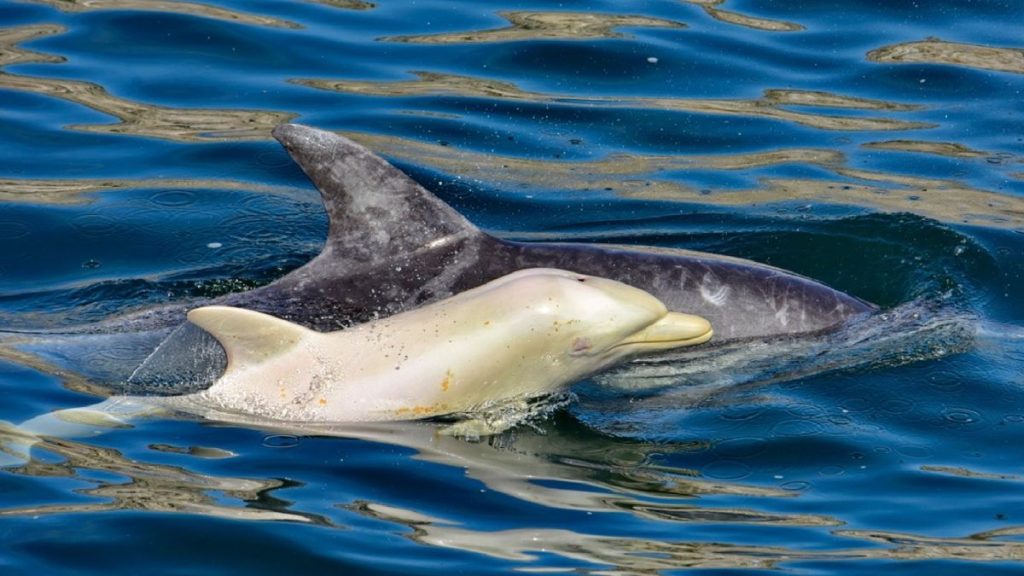[]
The albino bottlenose dolphin calf surfaces nect to an adult dolphin in South Africa’s Algoa Bay. (Image credit: Lloyd Edwards/Raggy Charters)[]Newlyweds were treated to an incredibly rare sight on their wedding day when the whale-watching vessel they were aboard encountered an albino dolphin calf — likely the first of its kind seen in Africa.
[]The lucky couple, along with their family and friends, saw the unusually colored cetacean April 4 onboard a Raggy Charters (opens in new tab) vessel in Algoa Bay, a marine wildlife hotspot in South Africa’s Eastern Cape province. Lloyd Edwards, boat captain and owner of Raggy Charters, was the first to spot the ghostly creature among a large pod of Indo-Pacific bottlenose dolphins (Tursiops aduncus).
[]”All of a sudden, I saw a white flash in the water among a pod of around 200 dolphins,” Edwards wrote on Facebook (opens in new tab). “When I saw it again, there it was, a beautiful [albino] calf.” It is the first recorded sighting of an albino bottlenose dolphin in Africa, he added.
[]The calf, which is likely around a month old and measures around 3.3 feet (1 meter) long, is most likely a true albino, but this is hard to tell from pictures alone, experts told Live Science.
[]Related: In rare wildlife encounter, whale watchers spot two white killer whales off Japan
[]
A close-up of the white calf at the surface. (Image credit: Lloyd Edwards/Raggy Charters)[]Albinism is a genetic condition that prevents animals from producing the pigment melanin, which gives color to their skin, fur, feathers and eyes. As a result, albino animals appear white in color and have pink eyes — both of which are more susceptible to light than normal. Albinism can often be confused with leucism, a condition that prevents individual cells from producing melanin. Leucistic animals can either be completely white, a dull yellow color or have patches of both mixed with their normal coloration. To a casual observer, it can be hard to tell the difference between the two conditions.
[]The dolphin’s solid white coloration hints that it is a true albino, rather than being leucistic, Erich Hoyt, a research fellow at Whale and Dolphin Conservation (WDC) in the U.K. and author of the “Encyclopedia of Whales, Dolphins and Porpoises (opens in new tab),” (Firefly Books, 2017) told Live Science in an email.
[]The fact that you can’t see the color of the dolphin’s eyes makes it harder to tell for certain if it is an albino, Hoyt said. However, it is possible that the individual’s eyes are closed because their eyes are unusually sensitive to light, he added. But genetic testing is the only way to say for sure, Hoyt said.
{ window.reliableDOMContentLoaded.then(() => { var componentContainer = document.querySelector(“#slice-container-DWQTyZFMrkwqQgwCTMpDaM-imageGallery-6”); if (componentContainer) { var data = {“galleryData”:[{“title”:””,”description”:[],”image”:{“id”:”aumDgZNjYydoGL4FDMsENf”,”name”:”Untitled(5).jpg”,”caption”:”The albino’s white dorsal fin sticks out of the water.”,”credit”:{“text”:”(Image credit: {subject})”,”subject”:”Lloyd Edwards/Raggy Charters”},”src”:”https://cdn.mos.cms.futurecdn.net/aumDgZNjYydoGL4FDMsENf.jpg”,”alt”:”A white dorsal fin is surrounded by gray fins at the surface.”,”width”:1600,”height”:900,”srcSetSizes”:[320,480,650,970,1024,1200],”sizes”:{“default”:”calc(100vw – 40px)”,”1000px”:”970px”},”fullscreen”:false,”lazyLoading”:true,”addSEOMetaData”:false,”eager”:false,”removeNativeWidthRestriction”:false,”dataBordeauxImageCheckAttr”:false}},{“title”:””,”description”:[],”image”:{“id”:”7oDbCeUBNv9giKmtTUcene”,”name”:”Untitled(1).jpg”,”caption”:”The white calf swim alongside another dolphin.”,”credit”:{“text”:”(Image credit: {subject})”,”subject”:”Lloyd Edwards/Raggy Charters”},”src”:”https://cdn.mos.cms.futurecdn.net/7oDbCeUBNv9giKmtTUcene.jpg”,”alt”:”The white dolphin swim alongside another dolphin.”,”width”:1600,”height”:900,”srcSetSizes”:[320,480,650,970,1024,1200],”sizes”:{“default”:”calc(100vw – 40px)”,”1000px”:”970px”},”fullscreen”:false,”lazyLoading”:true,”addSEOMetaData”:false,”eager”:false,”removeNativeWidthRestriction”:false,”dataBordeauxImageCheckAttr”:false}}],”progressText”:”Image {currentSlide} of {totalSlides}”,”viewOriginalText”:”View Original”}; var triggerHydrate = function() { window.sliceComponents.imageGallery.hydrate(data, componentContainer); } var triggerScriptLoadThenHydrate = function() { if (window.sliceComponents.imageGallery === undefined) { var script = document.createElement(‘script’); script.src = ‘https://slice.vanilla.futurecdn.net/11-0-2/js/imageGallery.js’; script.async = true; script.id = ‘vanilla-slice-DWQTyZFMrkwqQgwCTMpDaM-imageGallery-6-component-script’; script.onload = () => { window.sliceComponents.imageGallery = imageGallery; triggerHydrate(); }; document.head.append(script); } else { triggerHydrate(); } } if (window.lazyObserveElement) { window.lazyObserveElement(componentContainer, triggerScriptLoadThenHydrate, 1500); } else { console.log(‘Could not lazy load slice JS for DWQTyZFMrkwqQgwCTMpDaM-imageGallery-6’) } } }).catch(err => console.log(‘Hydration Script has failed for DWQTyZFMrkwqQgwCTMpDaM-imageGallery-6 Slice’, err)); }).catch(err => console.log(‘Externals script failed to load’, err)); ]]>[]Image 1 of 2
The albino’s white dorsal fin sticks out of the water. (Image credit: Lloyd Edwards/Raggy Charters)The white calf swim alongside another dolphin. (Image credit: Lloyd Edwards/Raggy Charters)[]For some animals, being albino can greatly decrease their chances of survival, which is why albinism remains very rare in the wild and more common in zoos and aquariums. But for this individual, that may not be the case.
[]”I would say there’s a good chance this albino will survive to adulthood,” if it survives the next few months, Hoyt said. “Albinos in most species are at risk as they stand out [to predators], he added, “but the potential predators of bottlenose dolphins are very few and colour would not make a difference to potential predators,” such as orcas or large sharks.
[]The calf’s poor vision also shouldn’t impact it in later life as dolphins use sound to communicate and hunt, Hoyt said. This individual will also likely be able to have normal-colored calves in the future unless its partner also possesses albino genes, he added. (Albinism is a recessive trait, meaning both parents must have a copy of the albino gene for their offspring to demonstrate the trait.)
[]This is not the first time that a young albino dolphin has been spotted. In June 2017, a 3-year-old albino Risso’s dolphin (Grampus griseus) was spotted swimming with its mom in California’s Monterey Bay. This individual was also in good health and had great chances of survival, experts told Live Science at the time.

